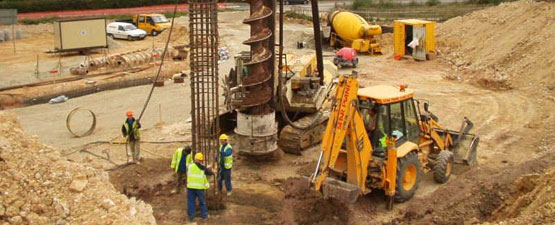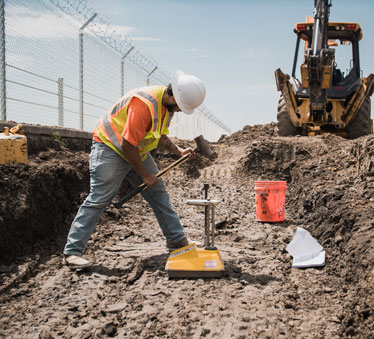Exploring the Conveniences of Geo Tech Engineering for Urban Planning
Wiki Article
A Comprehensive Check Out the Extent of Method for Geotechnical Designers and Their Influence On Task Expediency and Risk Reduction
The scope of technique for geotechnical designers includes a variety of crucial duties that directly influence job expediency and risk administration. What certain techniques do geotechnical engineers utilize to browse these complexities effectively?Roles and Responsibilities of Geotechnical Engineers
Geotechnical engineers play an important function in the foundation of construction projects, making sure that structures are improved solid ground. Their obligations include a series of activities necessary for examining soil and rock residential or commercial properties, which straight affect job usefulness and security. Geotechnical designers conduct website investigations to gather essential information relating to subsurface conditions. This includes boring boreholes, tasting soil and rock, and carrying out in-situ tests to identify product characteristics.
Collaboration is additionally an essential facet of their duty; they work closely with civil engineers, designers, and environmental professionals to make sure that geotechnical considerations are incorporated right into total job planning. Ultimately, the experience of geotechnical designers is vital in promoting the safety, sustainability, and feasibility of building and construction endeavors.
Trick Areas of Geotechnical Analysis
Dirt examples and geological surveys are fundamental elements in the crucial locations of geotechnical analysis. These activities offer critical information regarding the physical and chemical buildings of the subsurface products, enabling engineers to analyze site problems accurately. The evaluation normally incorporates dirt classification, compaction, shear toughness, and permeability, every one of which are vital for understanding the habits of soils under different loading problems.Another substantial area of focus is slope security analysis, which reviews the threat of landslides or dirt erosion. This entails examining the geometry of slopes, soil types, and groundwater conditions. Site characterization is additionally essential, as it involves a detailed investigation of the site's history, consisting of previous building and construction, contamination, and all-natural risks.
In addition, groundwater analysis plays a vital duty in geotechnical evaluation, affecting both the layout and building stages. Understanding the groundwater table, circulation instructions, and possible changes is essential for reliable structure style and stormwater monitoring.
Together, these essential areas of geotechnical evaluation form a comprehensive structure that educates decision-making procedures, guaranteeing safe and lasting engineering techniques while reducing potential dangers associated with subsurface problems.
Influence On Project Feasibility
The usefulness of a building job hinges dramatically on the insights acquired from geotechnical investigations. These investigations supply important information regarding soil residential or commercial properties, groundwater conditions, and subsurface characteristics, which are crucial for establishing the viability of a site for construction. By evaluating aspects such as soil bearing ability, negotiation possibility, and slope security, geotechnical engineers play an essential role in evaluating whether a project can proceed as prepared or if alterations are needed.Moreover, the outcomes of geotechnical researches directly affect job layout and construction techniques. Precise geotechnical data enables informed decision-making, ensuring that structural layouts fit site-specific conditions and abide with regulatory requirements. This process assists in maximizing resource allotment, therefore decreasing unforeseen delays and price overruns.
Additionally, a detailed geotechnical evaluation boosts the general stability of a job by recognizing potential obstacles early in the planning phase. By dealing with these obstacles proactively, stakeholders can boost the project's probability of success, guaranteeing that it fulfills both monetary and useful objectives. In recap, the contributions of geotechnical designers are indispensable to developing task usefulness, therefore laying the groundwork for effective job execution.
Risk Mitigation Techniques
While construction tasks naturally include different uncertainties, implementing efficient risk reduction strategies can substantially reduce potential problems developing from geotechnical variables. Geotechnical engineers play a crucial function in identifying, examining, and resolving dangers linked with subsurface conditions, making sure that projects proceed smoothly and continue to be within spending plan.One key method entails thorough website investigations, which include soil sampling, in-situ screening, and lab analysis. These evaluations give crucial data on soil toughness, structure, and actions, enabling designers to make foundations and earthworks that are both effective and risk-free. In addition, using sophisticated modeling techniques, such as finite component evaluation, permits engineers to predict just how dirt and architectural interactions might advance under various loading conditions.
An additional efficient reduction technique is the application of suitable layout alterations, such as utilizing reinforcement techniques or taking on different construction methods, which can enhance stability and lower vulnerability to geotechnical problems. In addition, continual surveillance of website problems throughout building can assist in timely treatments, hence reducing the probability of unpredicted problems.
Instance Studies and Real-World Applications
Study supply important understandings right into the useful applications of geotechnical engineering principles and highlight the effectiveness of danger reduction approaches in real-world scenarios. One notable example is the building of the Centuries Dome in London, where cutting-edge ground therapy strategies were applied to resolve difficult soil conditions. By utilizing deep cement blending and dirt stabilization methods, engineers successfully developed a secure structure that mitigated prospective settlement threats, making sure the project's usefulness.One more instance is the stabilization of the hillside for the new freeway in The golden state, where comprehensive incline analysis and surveillance were employed. Geotechnical designers used retaining walls and drainage systems to take care of groundwater, substantially lowering the danger of landslides. This aggressive method not just protected the stability of the freeway but also improved public safety.
Moreover, the expansion of a significant airport terminal demonstrated the significance of detailed site examinations. geotechnical industry. Geotechnical designers identified problematic dirt layers and suggested specific structure styles, bring about a successful job conclusion with reduced delays. These situation research studies emphasize the crucial role that geotechnical engineers play in examining risks and implementing effective solutions, thereby improving job feasibility and overall success
Verdict

By evaluating variables such as dirt bearing capability, settlement possibility, and slope security, geotechnical engineers play a pivotal function in evaluating whether a job can proceed as prepared or if adjustments are necessary.
In recap, the contributions of geotechnical engineers are integral to establishing task feasibility, therefore laying the foundation for efficient project implementation.
Geotechnical designers identified troublesome dirt layers and suggested details foundation styles, leading to an effective project conclusion with reduced hold-ups. geotech engineer. These situation researches underscore the vital function that geotech engineer geotechnical designers play in assessing dangers and implementing efficient options, therefore enhancing job usefulness and total success
Through efficient danger reduction approaches and the application of advanced modeling methods, geotechnical designers boost task outcomes and reduce risks associated to dirt and groundwater problems.
Report this wiki page